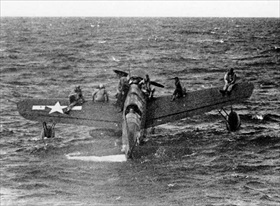ACE U.S. SUB TANG LOST
Off the China Coast · October 25, 1944
By October 1944 U.S. Navy submarine Tang and her skipper Richard O’Kane were legendary. (O’Kane had earlier made a name for himself aboard the Wahoo as executive officer under Dudley Walker “Mush” Morton.) The Tang, a Balao-class submarine, was credited during the war years with sinking 31 enemy ships totaling over 230,000 tons and damaging two more for 4,200 tons; rescuing more downed airmen; and pulling off more daring surface attacks with its 5‑inch/25‑caliber deck gun and two cannons than any other Allied submarine in the Pacific. And then on this date in 1944, while in the Formosa Strait on her fifth patrol, tragedy struck when, twenty seconds after its launch, the Tang’s own Mk 18 torpedo boomeranged, struck her in the aft torpedo room, and sank her in 180 ft of water. Of the nine officers and men on the bridge, three were picked up eight hours later. Five from below the hatches used a primitive emergency escape device called the Momsen lung to reach the surface and were able to remain afloat until rescued. A total of 78 men were lost. A Japanese destroyer picked up the survivors the next morning. On board the destroyer were some injured victims of the Tang’s previous sinkings, who tortured the submariners, kicking, rifle-butting, and burning them with cigarettes. The Tang crewmen were taken to the Japanese Navy Yokosuka Guard Unit Ueki Detachment, a secret prison unofficially known as the “Torture Farm.” Along with other submarine survivors, Tang crew members were labeled “special” prisoners and accused of making war on civilians because 90 percent of the crews on Japanese merchant ships were civilians. The men were put on half-rations. The Red Cross was not notified of the capture of the Tang survivors owing to their special status. Later the survivors were transferred to a camp on Tokyo’s outskirts, where they labored clearing away wreckage from Allied air raids. There they remained, close to death, until their liberation in August 1945. O’Kane, who earned a Congressional Medal of Honor for his last two engagements, weighed only 88 pounds when freed.
[amazon_carousel widget_type=”ASINList” width=”600″ height=”200″ title=”Recommended Reading” market_place=”US” shuffle_products=”False” show_border=”False” asin=”0306815192,0891415734,0451238109,0743487990,047119705X,1599219344,1841768596,1442169389,0252066707,089141889X” /]
U.S. Submarine Tang, 1943–1944
 |  |
Left: Commander Dudley “Mush” Morton (left) speaks with his executive officer, Richard O’Kane, on the bridge of the Wahoo days after torpedoing the Japanese troop transport Buyo Maru, north of New Guinea, on January 26, 1943, on the sub’s third patrol. O’Kane was the Wahoo’s executive officer on the first five of her seven war patrols before leaving to assume command of the USS Tang. He credited much of his success as the Tang’s skipper to the training he received serving under Morton.
![]()
Right: The Momsen lung shown here during a training exercise was a primitive underwater rebreather stored aboard U.S. submarines as emergency escape gear. The Momsen lung cleaned and recycled the user’s expelled air. The only known emergency use of the Momsen lung was during the escape from the Tang on October 25, 1944.
 |  |
Left: The loss of the Tang by her own torpedo, the last one fired on the most successful patrol ever made by a U.S. submarine, was a singular misfortune. Twenty-two of Tang’s torpedoes found their mark in enemy ships, sinking 13 of them; one missed. O’Kane received the Congressional Medal of Honor for the Tang’s final action on October 24 and 25, 1944, when the sub interrupted heavily loaded Japanese transports and a tanker en route to the Philippines. (The recapture of the Philippines had begun with Gen. Douglas MacArthur’s landing on Leyte Island on October 20, 1944, and the naval battle of Leyte Gulf (October 23–26) was in full swing).
![]()
Right: Downed U.S. airmen on a Vought OS2U Kingfisher near Truk Lagoon await rescue by the USS Tang, 1944. (The OS2U was a catapult-launched observation floatplane.) On her second war patrol, the Tang was assigned to lifeguard duty near Truk. The Tang rescued 22 downed airmen and transported them to Hawaii at the conclusion of her patrol.
Story of World War II Submarine Warfare in the Pacific. Introduced by Vice Admiral Charles A. Lockwood, Jr, Commander of Pacific Submarine Forces (COMSUBPAC) and Narrated by Gene Kelly
![]()

 History buffs, there is good news! The Daily Chronicles of World War II is now available as an ebook for $4.99 on Amazon.com. Containing a year’s worth of dated entries from this website, the ebook brings the story of this tumultuous era to life in a compelling, authoritative, and succinct manner. Featuring inventive navigation aids, the ebook enables readers to instantly move forward or backward by month and date to different dated entries. Simple and elegant! Click
History buffs, there is good news! The Daily Chronicles of World War II is now available as an ebook for $4.99 on Amazon.com. Containing a year’s worth of dated entries from this website, the ebook brings the story of this tumultuous era to life in a compelling, authoritative, and succinct manner. Featuring inventive navigation aids, the ebook enables readers to instantly move forward or backward by month and date to different dated entries. Simple and elegant! Click 











